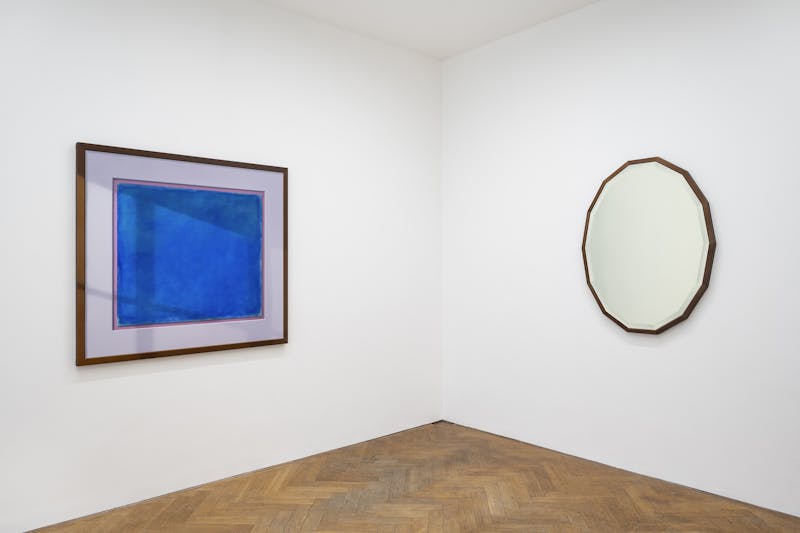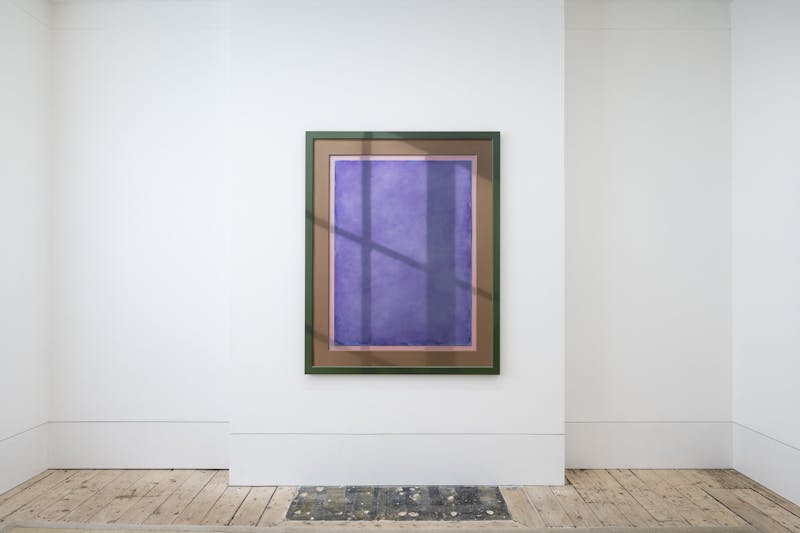Personal predilections are worth setting to one side for this exhibition: Christopher Page’s dexterity with a brush will confound your retinas, whatever your taste or preference in art. On entering, I peer into what seems to be an innocent mirror to organise my unkempt fringe. It soon becomes clear, it’s not a mirror at all but a painting – he got me.
The precision with which Page commands illusion with paint strikes instantly and with palpable believability. Across the two-roomed gallery are just six of his ruses: three supposed mirrors and three framed brightly coloured paintings, all hung with enough space around them to be taken in as a group from a distance. It’s the kind of exhibition that warrants such scope, too – orbiting each image from all angles is the best way to appreciate Page’s scrupulous attention to detail and sleight of hand.
The framed paintings, at first glance, look like Mark Rothko knockoffs from the 1950s, each hung inside oak frames – colour fields in blue, purple and green. On getting closer, Page’s finesse for his medium completely subverts these seemingly ordinary pictures. Every inch is a painted concoction. The shadows, and the play of the light across the ‘glass’: paint. The contours and joins: all fake too, air-brushed to near-perfection. Oddly enough – the painted wood frames lack realistic details – the texture and knots have been missed out, as if Page omitted them intentionally, as a clue.

Christopher Page, Late Modern, 2021. Interior Dawn, 2021
Each of these self-aware paintings are stiffened in a feigned glow, their intensity shifting as flecks of real sunlight beyond the gallery interfere and bend on to their shadows, mutating throughout the day. ‘Late Modern’, which is probably the quietest and most compelling of the trio, has the faintest dappled shadow, so muffled it looks utterly authentic. ‘Fading Light’ is much more assertive and pronounced in its execution. ‘Early Modern’ strikes somewhere in between the two – veiled by definite outlines with an ominous air, as if it were a depiction of a window left open in a horror film.

Christopher Page, Interior, Fading Light, 2021
These shadow paintings are unashamedly self-conscious – peacocks, demanding to be scrutinised and admired. But the three mirror paintings dotted among them are more uncertain of themselves – acting as apertures for viewing the room with sharper, forensic eyes. Although they don’t reflect as mirrors should, I became acutely aware of my own subtle movements, scurrying and teetering to get closer. They impel you to study yourself even without a reflection. Painted in shades of pale yellows and greys, they catch none of the passing light; instead, my own shadow merges to create flittering illusions on their surfaces. Page titles them as ‘Interior’ followed by the time of day, the gleaming gradient in each tracing subtle light shifts from dawn to dusk. The most convincing mirror – the one which fooled me as I entered – is ‘Interior, Dawn’. It assists its neighbouring painting, ‘Late Modern’, in flourishing – as if it were a spoonful of lemon sorbet cleansing the palette between courses.
‘Shadows & Reflections’ rewards devoted viewing – full cooperation, beady-eyes, return visits at morning and close of day. Paintings that replicate reality so finitely can sometimes fall short, lacking personality. Here, however, it’s Page’s addition of false shadows and nonreflecting mirrors that make it an experience in perception and presence, on what is and isn’t there.